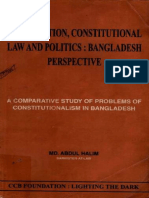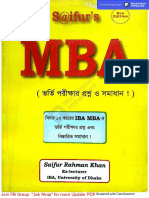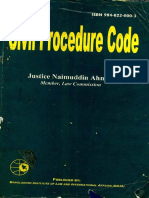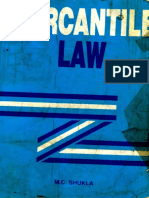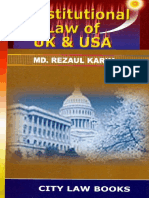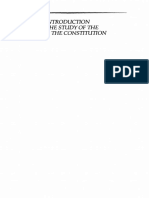Professional Documents
Culture Documents
Textbook On Civil Procedure by Abdul Halim
Uploaded by
Md Ahsan-Ul- Kabir0 ratings0% found this document useful (0 votes)
124 views165 pagesfewfsdsdf
Original Title
Textbook on Civil Procedure by Abdul Halim
Copyright
© © All Rights Reserved
Available Formats
PDF or read online from Scribd
Share this document
Did you find this document useful?
Is this content inappropriate?
Report this Documentfewfsdsdf
Copyright:
© All Rights Reserved
Available Formats
Download as PDF or read online from Scribd
0 ratings0% found this document useful (0 votes)
124 views165 pagesTextbook On Civil Procedure by Abdul Halim
Uploaded by
Md Ahsan-Ul- Kabirfewfsdsdf
Copyright:
© All Rights Reserved
Available Formats
Download as PDF or read online from Scribd
You are on page 1of 165
TEXTBOOK
ON
CIVIL PROCEDURE
MD. ABDUL HALIM
Se Tee SC eeTea Ply
Pee cone
November, 2009
February, 2011
January, 2019
Eleventh Edition : August, 2019
Twelfth Edition : November, 2020
Thirteenth Edition : January, 2021
ISBN : 978-984-95005-3-7
Price : Tk. 650.00 only
Cover Design :
Sojoni Art Publications
First Edition
Second Edition
CONTENTS
PART-A
Chapter-I
CODE OF CIVIL PROCEDURE:
MEANING, NATURE AND OBJECT 15-39
Meaning of Civil Procedure 15
Substantive law and procedural law 15
No vested right on the procedural law . 16
No presumption against retrospective operation 16
Nature of procedural law 16
Nature of CPC \7
Scope and applicability of CPC 18
Is CPC an Act of parliament? 19
Is CPC a Code? 19
Mere irregularity in the procedure of the Code 22
Discretionary power 22
Is the Code exhaustive? 23
Power of civil and criminal courts compared 24
History of the Code 24
First Code in India: The Code of 1859 25
Second Code in India: The Code of 1877 25
Third Code in India: The Code of 1882 25
Fourth Code in India: The Coe of 1908: Present Code 26
Arrangement of the Code 27
Sections and Rules in CPC 27
Extent of High Court Division’s power to make rules 2
Letters Patent
Jurisprudence of Rules: Divergence and Advantages 29
The Rule Committee
30.
Composition of the Rule Committee 30
Chapter-II
SUBORDINATE CIVIL COURTS AND
THEIR POWERS AND JURISDICTIONS 3140
Diagram of civil courts 31
Introduction 31
Subordinate civil courts 32
Different classes of civil courts 32
Jurisdiction of civil courts 33
Territorial Jurisdiction
Subject matter Jurisdiction
Pecuniary Jurisdiction
Original and Appellate Jurisdiction
Appeals- Wherefrom and to which Court
Administrative or transferred jurisdiction
Jurisdiction to transfer or withdraw cases
The Court of the District Judge 36
The Court of the Additional District Judge 37
The Court of the Joint District Judge 38
The Court of the Senior Assistant Judge 38
The Court of the Assistant Judge 39
Jurisdictional conditions under CPC 39
Court to try all civil suits unless barred
Saving of special procedure
Stay of suits
Res Judicata
Courts in which suit to be instituted
Suits to be instituted where subject matter situate
General rules on jurisdiction 40
Chapter-II
TERMS DEFINED AND EXPLAINED 41-64
Suits of Civil Nature 41
Decree 42
-Elements of a decree 42
-What a decree shall include 44
-Preliminary and final decree 44
-Partly preliminary and partly final decree 46
Order 47
-Distinction between orders and decree 47
Similarities between decree and orders 47
Mesne Profits 48
-Nature 48
-Principles 48
Object of Mesne profit 49
Against whom msne profit can be claimed 49
-Assessment 50
Test 7 50
-Interest 50
Pleader
Interpleader Suit
Conditions of interpleader suit
-Exceptions to interpleader suit
-Plaint in interpleader suit
Pauper Suit
-Conditions of pauper suit
-Rejection of pauper application
-Dispaupering
-Costs where pauper succeeds
-Procedure where pauper fails
Suits involving substantial question as to
interpretation of Constitutional Law
Representative Suit
-Essentials of representative suit
-Purpose of representative suit
Cause of Action
Suits to be filed in court where cause of action arises
-Joinder of causes of action
Objections with regard to misjoinder
Set Off
-lilustration
Conditions of set-off
-Distinction between set-off and counter claim
Legal Representative
Exparte Decree
-Conditions of exparte decree
-Setting aside exparte decree
-Effect of exparte decree
-Remedies to defendent of exparte decree
Local Investigation
Conditions of local investigation
Chapter-IV
CIVIL PROCEEDINGS: VARIOUS STAGES
Nature of a Civil Proceeding
59
66
Stages in a Civil Proceeding
Pre-Proceeding Stage 67
Proceeding Stage 67
Issue of plaint
Issue of process
Service of summons
Return of summons and filing of written statement
Alternative Dispute Resolution (ADR)
First hearing
Framing of Issues
Settling of date for Hearing (SD)
Trial Stage 7
Opening of the case
Peremptory hearing and examination in chief
Cross examination and re-examination
Argument
Judgment 75
Pronouncement of judgment
Decree or order
Enforcement and Execution of Decree 75
Application
Hearing '
Show cause notice for execution
Procedure after notice
Mode of execution
Chapter-V
PARTIES TO A CIVIL SUIT 77-82
Types of parties to suit 71
Parties to a civil suit 7
Joinder of parties 77
Joinder of defendants 77
Necessary and proper parties 78
Misjoinder of parties 78
Misjoinder or non-joinder of plaintiff's 79
Misjoinder or nonjoinder of defendants 79
Effect of misjoinder or non-joinder of parties 79
Objection as to misjoinder of nonjoinder of parties 79
Misjoinder of causes of action aa
Joinder of causes of action and jurisdiction of court
Joinder of causes of action with regard to immovable
property
Exceptions
Striking out or addition of parties
Court may strike out or add parties
Consequences of addition
Chapter-VI
INSTITUTION OF CIVIL SUITS
Where to be instituted?
How to institute?
Objection with regard to jurisdiction
Institution of a civil suit
In which court a suit relating to immovable
property is to be instituted
Provisions of section 20
Suit for damages for tortuous activity of a
Government employee
Chapter-VII
PLEADINGS IN CIVIL SUITS
Pleadings .
Object of pleadings
Plaint
Ingredients of plaint
Ingredients of written statement
Rejection and return of plaint
Rejection of plaint
Remedies against rejection of plaint
Rejection of plaint and return of plaint
Amendment of plaint
‘Amendment after judgment
When will court refuse to allow amendment
‘Amendment of pleadings
Conditions of amendment of pleadings
Chapter-VIT
WRITTEN STATEMENT, SET-OFF AND +
COUNTR-CLAIM
Introduction
Ingredients of a written statement
Set-off
Illustration
Conditions of set-off
Effect of set-off
Legal set-off
Equitable set-off
Distinction between legal set-off and equitab! -«
Counter-claim by defendant ndequitable set-off oe
Distinction between set-off and counter-claim 100
Chapter-IX
ISSUE AND SERVICE OF SUMMONS 101-108
Summons: meaning TOL
Issue of summons 101
Essentials of summons 101
Object of service of summons 101
Mode of service of summons 102
Personal service of summons 102
Service by affixation 103
Service by post 104
Service by courier service 104
Service by email 105
Substituted service 105
Method of substituted service 105
Effect of substituted service 106
Where service substituted, time for appeatance 106
Service in special cases 106
Service of summons where the defendant
resides within jurisdiction of the another court 107
Service of summons outside Bangladesh 107
Onus as to proof of due service of summons 107
Service where defendant resides out of Bangladesh
and has no agent 108
Service of summons when completed 108
Consequence of not serving summons within time 108
Chapter-X
RES SUB JUDICE AND RES JUDICATA 109-114
Res sub-judice: stay of suit 109
Conditions of res sub-judice 109
Object of stay of suit 110
Test of stay of suit 110
Res judicata a
Object of res judicata i a
Conditions of res judicata
. a 112
Illustration of res judicata - 113
Res judicata and judicial precedent
Res judicata and estoppel
Types of res judicata oa
Whether exparte decree works as res judicata
Chapter-XI
TRANSFER OF CIVIL SUITS
Two types of transfer
General power of transfer
-Grounds of transfer
-Principles of transfer
-Transfer to which court
~Section 24
Special power of transfer
-Application
-Conditions of transfer
-To which court to transfer
Chapter-X11
CIVIL APPEAL
Appeal
General rules as to appeal
Civil appeal in diagram
Power of appellate court
Provisions of appeal in CPC
Provisions of appeal in Civil Courts Act
Appeal against preliminary decree
Appeal against exparte decree
No appeal against consent decree
Procedure of appeal
Form of appeal
Who can prefer appeal
Appeal against orders
Chapter-XIIT
CIVIL REVISION
Nature of civil revision
Conditions of civil revision
-Revisional power of the HCD
-Revisional power of the District Judge
-Second revision to the HCD
-Dual forum of revision from the same decree
-Nirmol Chandra Datta v Anser Ahmed
Jyosna Ara Amin «
113
114
114
15-118
115
115
115
115
16
116
117
117
118
118
119-126
119
119
120
121
121
121
122
122
123
123
123
124
124
127-138
127
127
128
128
129
130
130
131
-Khurshed Ali v Hashem Ali 133
-Appellate Division's view 134
-Problem with the Appellate Division's view 135
Distinction between appeal and revision 136
Reference 136
Review 137
Remedies against interlocutory order 137
Chapter-XIV
INHERENT POWERS OF THE CIVIL COURTS 139- 144
Introduction 139
Section 151 139
Reasoning of inherent power 139
Nature of inherent power 141
Instances of inherent power 141
Where inherent power cannot be exercised 141
. The Code recognises the
distinction between a proceeding commenced by an
application and a proceeding commenced by a plaint. A
proceeding commenced by an application is not suit and
cannot have a decree.
Determination of the rights of the parties: The
adjudication must determine the rights of the parties
with regard to all or any of the matters in controversy.
The term “determination of the rights of the parties”
refers to the substantive rights of the parties with regard
to the matters of the case and not to other matters of the
dispute which are ancillary to the subject matter of the
suit. For example, a question relating to the jurisdiction
3
Venkata Chandrappa v Venkatarama Reddi LR 22 Mad. 256.
Terms Defined and Explained
tation or other preliminary points, if
decided in favour of the plaintiff, would not determing
the rights of the parties in relation to the ‘suit. The
expression “matters in controversy in the suit” connotes
matters as have been brought up for adjudication by the
ings. a
ae Adjudication: The adjudication Must be
conclusive. An order can be a decree only if it
conclusively determines the rights of the parties
completely and finally. An order is not a decree When it
merely determines an incidental question. Incidental
order directing an inquiry regarding mesne profits, for
appointing a receiver, granting an injunction etc. are not
decisions which conclusively determines the rights of
the parties.
of the court or limi
(iy)
What a Decree shall include?
Section 2(2) also specifies that a decree shall include-
(a) Rejection ofa plaint; and
(b) determination of any question with regard to an
application for restoration under section 144 of the Code.
What a Decree shall not include?
Section 2(2) specifies that a decree shall not include-
(c) any adjudication from which an appeal lies as an appeal
from an order, or
(d) any order of dismissal for default.
Preliminary and Final Decree
The explanation given in section 2(2) specifies four types of
decrees: (i) final decree; and (ii) preliminary decree; again (i)
partly final decree; and (ii) partly preliminary decree.
Again, a closer look to the whole sub-section 2(2) reveal that
the Code recognises the following types of decrees:
(1) Preliminary Decree;
(2) Final Decree;
(3) Partly preliminary decree;
Textbook on Civil Procedure 45
(4) Partly final decree;
(5) order rejecting a plaint; and
(6) determination of a question within section 144.
Decree in Appeal:
A decree passed in appeal is really a decree in the suit, for, an
appeal is only a continuation of the suit.
Consent Decree:
A compromise or a consent decree is a decree within the
meaning of this sub-section. The basis of compromise is the
contract entered into between the parties, but once a decree based
on compromise has been made, the compromise merges into it and
it operates as a decreet.
Preliminary and Final Decree:
A decree is preliminary when further proceedings have to be
taken before the suit can be completely disposed of. It is final
when such adjudication completely disposes of the suit. In other
words, a preliminary decree is passed in those cases in which the
Court has first to adjudicate upon the rights of the parties and has
then to stay its hand, for the time being, until it is in a position to
pass a final decree in the suit.
The Code provides for the passing of preliminary decrees in the
following classes of cases:
Serial No. | Order __| Rule subject matter
1 20 12 Suits for possession and for rent or
mesne profit.
2 30 |__| Administration suits
3 20 14 Suits for pre-emption. _|
4 20 15 Suits for dissolution of partnership. |
5 20 16 Suits for accounts between
rincipal and agent.
6 20 18 Suits for partition and separate
possession.
4 Fakir Panda v Puni Devi (1974) 40 Cut. L.T. 1183
46 Terms Defined and Explained
34 2,3
34 4,5
9 [34 17,8
There is a difference of opinion as to’ whether the list ig
exhaustive of the cases in which a preliminary decree can be
passed. In an earlier case of the Calcutta High Court it was held
that except in cases expressly provided for in the Code no
preliminary decree can be passed. A later case of the same High
Court held that the list is not exhaustive. The Bombay High Court
also has held to the same effect®.
Decree partly preliminary and partly final:
A decree may be partly preliminary and partly final. Thus,
where in a suit for possession of immovable property with mesne
profit, the court-
(a) decrees the possession of the property, and
(b) directs an enquiry into the mesne profits,
the portion (a) is final decree and the portion (0) is a
preliminary decree. Similarly, a direction in the final decree
leaving distribution of assets undisposed of is in essence a
preliminary decree and the decree is partly final and partly
preliminary. More lucidly, a plaintiff may join two claims for
possession and mesne profits in one suit. When a decree is made
for possession, that portion of the decree is final; and when a
decree is made for mesne profit, it is only preliminary, because the
final decree for mesne profit cannot be made unless the amount
due is found upon further inquiry. Therefore, further proceedings
have to be taken for ascertaining the amount due for mesne profit,
before the claim for mesne profits can be completely disposed of.
In such a suit, although one decree is made, it is partly preliminary
and partly final’.
—e.
5 AIR 1919 Cal 361 (362).
§ AIR 1921 Bom 220 (222).
7 Satish Chandra v Sarat Kamini (1929) Cal 383.
Suits for foreclosure of a mortgage
Suits for sale of mortgaged
roperty._
Suits for redemption of mortgage.
ola
Textbook on Civil Procedure 47
. Order
Section 2(14) defines ‘order’ to be a formal expression of any
decision of a Civil Court which is not a decree.
Distinction between Decree and Order
The adjudication of a court of law may be divided into two
classes, namely:
(i) decrees; and
(ii) orders.
All decrees are orders and not all orders are decrees. Whether
an order is a decree within the meaning of section 2 of the Code
depends upon its nature and contents. The definition of ‘decree’ is
not intended to include an interlocutory decision in ordinary suits,
upon each and every point in controversy between the parties. Both
decree and order are formal expression of decision of a civil court.
Therefore, the presence or absence of a formal expression cannot
be the true criterion of the difference between a decree and an
order. Reading the two definitions together, the essence of the
distinction seems to lie in the nature of the decision- whether it is
an adjudication of a particular kind or not- rather than in the
manner of its expression. Thus the main distinction between the
two is that a decree conclusively determines the rights between the
parties with regard to all or any of the matters in controversy
whereas an order does not do so.
Similarities between Order and Decree:
“@ Both are decisions given by a civil court,
(ii) Both are given in matters of controversy between
parties,
(iii) | Both are formal expressions of a decision.
Distinctions between Order and Decree:
i) _ A decree is only passed in a suit which has commenced
by presentation of a plaint. On the other hand, an order
may originate from a suit by presentati i
a ee y Presentation of a plaint or
48 Terms Defined and Explained
(ii) A decree is an adjudication which conclusive}
determines the rights of the parties with regard to all or
any of the matter in controversy. On the other hand, an
order may or may not finally determine such rights,
(iii) A decree may be preliminary or final, or Partly
preliminary and partly final. An order, on the other
hand, cannot be preliminary or partly final.
(iv) Except in certain suits, where two decrees, one
preliminary and one final are passed, in every suit there
can be only one decree. However, ina suit there may be
a number of orders passed by the court.
(vy) Every decree is usually appealable unless otherwise
provided whereas an order may not be appealable.
Orders are therefore divided into (i) appealable; and (ii)
non-appealable orders.
Mesne Profits
Section 2(12) defines that “mesne profits” of property means
those profits which the person in wrongful possession of such
Property actually received or might with ordinary diligence have
teceived therefrom together with interest on such profits but shall
not include profits due to improvements made by the person in
wrongful possession.
Nature: “Mesne profits” are in the nature of compensation or
damages which the court may mould according to the justice of the
case. A person wrongfully kept out of Possession is entitled to
recover not only the profits which the defendant could have made
while in Possession but also the loss that the plaintiff has sustained
by the withholding of the Possession.
Principles: The Principles upon which the court should
on to determine the mesne profit are now settled. They are as
Textbook on Civil Procedure 49
(i) The possession which has been wrongfully retained
should not be a source of profit to the wrongful
possessor.
(ii) The wrongful possessor should be made to pay to the
rightful owner any profit which he has made or could
with reasonable diligence have made.
(ii) The court should restore the status before the
dispossession of the decree-holder. In determining the
question of mesne profit the court should aim at doing
justice between the parties having regard to all the
circumstances of the case, the object being to see that
the person wrongfully kept out of possession is put in
the same position financially as if right had been done.
Object of Mesne Profit:
The object of awarding a decree for mesne profits is to
compensate the person who has been kept out of the possession
and deprived of enjoyment of his property even though he was
entitled to possession thereof.
Against whom mesne profit can be claimed:
Wrongful possession by a defendant is the essence of a claim
for mesne profits and the very foundation of a decree therefore.
Thus a person in wrongful possession and enjoyment of
immovable property is the one against whom claim for mesne
profit can be made.
Mesne profit cannot be claimed when there is no wrongful
possession. For instance, the possession of a co-sharer can never be
wrongful within the meaning of section 2(12) as he has a right and
interest in every inch of the undivided property. Therefore, one co-
sharer cannot claim mesne profit against the other, on the ground
that the latter was in wrongful possession (Shambhu Dayal
Khetan v Motilal Muraka AIR 1980 Pat 106).
Where a party to a suit claims mesne profit, he is in the
position of a plaintiff and if he adduces no evidence at all, no
mesne profits can be awarded to him (Ramakka v Negasami_ AIR
1925 Mad 145).
50 Terms Defined and Explained
Where the plaintiff is dispossessed by several Persons, every
one of them would be liable to pay mesne profits to the Plaintify, In
such a case the court may hold all the trespassers Jointly and
severely liable, leaving them to have their respective ‘Tights
adjusted in a separate suit for contribution; or may ascertain ang
apportion the liability of each of them
Assessment: Mesne profits being in the nature of damages, no
invariable rule governing their award and assessment in every case
can be laid down and the court may mould it according to the
justice of the case. In assessing the mesne profit, usually the court
will take into account what the defendant has gained or reasonably
might have gained by his wrongful possession of the property.
Test: The test to ascertain mesne profit is not what the
plaintiff has lost by being out of possession but what the defendant
gained or might reasonably and with ordinary prudence have
gained by such a wrongful possession.
Interest: The definition of ‘mesne profit’ as contained in
section 2(12) includes not only the profits of immovable property
but also interest on such profits. Since interest is an integral part of
mesne profit, it has to be allowed in the computation of mesne
profit itself. The rate of interest is at the discretion of the court.
Pleader
Section 2(15) of the Code of Civil Procedure defines ‘pleader’ as any
Person entitled to appear and plead for another in Court. Who is entitled
to appear and Plead for another in court? This has not been explained
anywhere in law. Normally an advocate enrolled under the Bangladesh
Legal Practitioners and Bar Council Order and Rules, 1972 is entitied to
appear and plead before any court. Thus an advocate is necessarily @
Pleader but can any other person be a pleader? Karlier there was
Provision in sub-section 2(15) that a pleader would include an advocate,
a vakil and an attorney of a High Court. Vakil, Mukiiter and attomey8-
ae
§ To learn more about these
Bangladesh, Chapter X1V, terms please see author's Legal System of
Textbook on Civil Procedure 51
these terms being almost obsolete and irrelevant in our legal system,
have been deleted from this sub-section in 1973. Article 19 of the
Bangladesh Legal Practitioners and Bar Council Order, 1972 provides
that no person shall be entitled to practise the profession of law unless he
is an advocate. This article also provides that an advocate shall be
entitled as of right to practise throughout Bangladesh and to appear and
plead before any court, tribunal or revenue authority in Bangladesh. Thus
it is clear that no one other than an advocate can be a pleader.
Interpleader Suit
Section 88 and Order XXXV of CPC deals with interpleader
suit. Where X is under a liability for any debt, sum of money, or
other property, claimed adversely by A or B or more, and he
desires protection against a wrong payment or delivery, he can file
‘a suit under section 88. The only way, in fact, in which he can
protect himself is by filing such a suit; otherwise, if he litigates
with the claimant separately, he would have to pay the costs of the
successful claimant. A suit under this section is called an
interpleader suit because the plaintiff is really not interested in the
matter, but only the defendants interplead as to their claims. In
each of the defendants so interpleading is virtually in the position
of a plaintiff and his claim will be governed by the rules of the
Limitation Act. In other words, an interpleader suit is one in which
the real dispute is between the defendants only and the defendants
interplead, that is to say, plead against each other instead of
pleading the plaintiff as in an ordinary suit. The primary object of
filing an interpleader suit is to have the claims of rival defendants
adjudicated.
Conditions of Interpleader Suit:
(i) In an interpleader suit the plaintiff must not himself
dispute the debt or claim the property; in other words, he
must not have any interest in the suit other than for
charges or cost.
(ii) Claims must be bonafide and adverse to one another
among the defendants. In other words, the defendants
i
52 Terms Defined and Explained
must claim the money OF property adversely to one
another from the plaintiff.
(iii) Claims must be with reference to the same subject-matter.
In other words, the rival claims must be with reference to
the same debt, sum of money or other property but not
necessarily to the same extent.
(iv) The plaintiff must be ready to pay or deliver the property
to the nghtful owner.
Exception to Interpleader Suit: The proviso to section 88 of
the CPC states that where any suit is pending in which the rights of
all parties can properly be decided, no such suit of interpleader
shall be instituted.
Plaint in Interpleader Suit: In every suit of interpleader the
plaint shall, in addition to other statements necessary for plaint,
state-
(a) that the plaintiff claims no interest in the subject-matter in
dispute other than for charges or costs;
(b) that claims made by the defendants severally; and
(c) that there is no collusion between the plaintiff and any of
the defendants (Or. 35, R.1).
Pauper Suit
Order 33 deals with the provisions of pauper suits. Rule 1 of
Order 33 prescribes that any suit may be instituted by a pauper.
And therefore, a suit instituted by a pauper is called pauper suit.
However, the question is- who is a pauper? The answer has been
given in the explanation of Rule 1. It states that a person is a
pauper-
a) when he is not possessed of sufficient means to enable
. him to pay the prescribed court fee for the suit; or
(ii) where no such court fee is prescribed, when he is not
entitled to property worth Taka five thousand other than
ie nesearaly wearing-apparel and the subject-matter of
Textbook on Civil Procedure 53
Thus the object of a pauper suit is to enable a person i
! w
peor we Eee fee aes for instituting a suit. aiiauen pe
it by a pauper plaintiff, the court has in
power to allow the defendant to defend in forma pice
(Doorga v Nittokally, 1LR § Cal 819). The provision of pauper suit
has been almost obsolete in Bangladesh’. This is because the
average cost of litigation, in view of lengthy and cumbersome
procedure, is so high that the question of only court fee is not a
factor to a litigant.
Conditions of a Pauper Suit:
The conditions and procedure of a paupel
been detailed in Rules 2-8 of Order 33. They are as follows:
(i) In a pauper suit there must be a separate pauper
application along with the plaint (Rule 2). This application
is to obtain the leave of the court to sue in forma
pauperies.
(ii) The pauper appl
movable or immovable p'
applicant.
(iii) The usual ru
the application to th
from appearing in the court, he
(Rule 3).
pauperism of the applicant or
(iv) The court may examine the
it may order that the applicant be examined by a
commission (Rule 4).
1 application have
ication shall contain a schedule of any
roperty belonging to the
le is that the applicant himself shall present
e court; however, if he is exempted
may present it by an agent
Rejection of a Pauper Application: .
Rule 5 specifies that a pauper application may be rejected on
any of the following grounds: . ;
(i) where the applicant is not framed and presented in the
manner prescribed by rules 2 and 3, or
9 Mahmudul Islam, The Law of Civil Procedure, Dhaka: Mollick Brothers,
2006, p. 1419
You might also like
- The Subtle Art of Not Giving a F*ck: A Counterintuitive Approach to Living a Good LifeFrom EverandThe Subtle Art of Not Giving a F*ck: A Counterintuitive Approach to Living a Good LifeRating: 4 out of 5 stars4/5 (5794)
- The Gifts of Imperfection: Let Go of Who You Think You're Supposed to Be and Embrace Who You AreFrom EverandThe Gifts of Imperfection: Let Go of Who You Think You're Supposed to Be and Embrace Who You AreRating: 4 out of 5 stars4/5 (1090)
- Never Split the Difference: Negotiating As If Your Life Depended On ItFrom EverandNever Split the Difference: Negotiating As If Your Life Depended On ItRating: 4.5 out of 5 stars4.5/5 (838)
- Hidden Figures: The American Dream and the Untold Story of the Black Women Mathematicians Who Helped Win the Space RaceFrom EverandHidden Figures: The American Dream and the Untold Story of the Black Women Mathematicians Who Helped Win the Space RaceRating: 4 out of 5 stars4/5 (895)
- Grit: The Power of Passion and PerseveranceFrom EverandGrit: The Power of Passion and PerseveranceRating: 4 out of 5 stars4/5 (588)
- Shoe Dog: A Memoir by the Creator of NikeFrom EverandShoe Dog: A Memoir by the Creator of NikeRating: 4.5 out of 5 stars4.5/5 (537)
- The Hard Thing About Hard Things: Building a Business When There Are No Easy AnswersFrom EverandThe Hard Thing About Hard Things: Building a Business When There Are No Easy AnswersRating: 4.5 out of 5 stars4.5/5 (344)
- Elon Musk: Tesla, SpaceX, and the Quest for a Fantastic FutureFrom EverandElon Musk: Tesla, SpaceX, and the Quest for a Fantastic FutureRating: 4.5 out of 5 stars4.5/5 (474)
- Her Body and Other Parties: StoriesFrom EverandHer Body and Other Parties: StoriesRating: 4 out of 5 stars4/5 (821)
- The Sympathizer: A Novel (Pulitzer Prize for Fiction)From EverandThe Sympathizer: A Novel (Pulitzer Prize for Fiction)Rating: 4.5 out of 5 stars4.5/5 (119)
- The Emperor of All Maladies: A Biography of CancerFrom EverandThe Emperor of All Maladies: A Biography of CancerRating: 4.5 out of 5 stars4.5/5 (271)
- The Little Book of Hygge: Danish Secrets to Happy LivingFrom EverandThe Little Book of Hygge: Danish Secrets to Happy LivingRating: 3.5 out of 5 stars3.5/5 (399)
- The World Is Flat 3.0: A Brief History of the Twenty-first CenturyFrom EverandThe World Is Flat 3.0: A Brief History of the Twenty-first CenturyRating: 3.5 out of 5 stars3.5/5 (2219)
- The Yellow House: A Memoir (2019 National Book Award Winner)From EverandThe Yellow House: A Memoir (2019 National Book Award Winner)Rating: 4 out of 5 stars4/5 (98)
- Devil in the Grove: Thurgood Marshall, the Groveland Boys, and the Dawn of a New AmericaFrom EverandDevil in the Grove: Thurgood Marshall, the Groveland Boys, and the Dawn of a New AmericaRating: 4.5 out of 5 stars4.5/5 (266)
- A Heartbreaking Work Of Staggering Genius: A Memoir Based on a True StoryFrom EverandA Heartbreaking Work Of Staggering Genius: A Memoir Based on a True StoryRating: 3.5 out of 5 stars3.5/5 (231)
- Team of Rivals: The Political Genius of Abraham LincolnFrom EverandTeam of Rivals: The Political Genius of Abraham LincolnRating: 4.5 out of 5 stars4.5/5 (234)
- MULLA On CPC PDFDocument2,712 pagesMULLA On CPC PDFADITYA SINGH100% (4)
- IPC KD Gaur PDFDocument685 pagesIPC KD Gaur PDFishika63% (8)
- On Fire: The (Burning) Case for a Green New DealFrom EverandOn Fire: The (Burning) Case for a Green New DealRating: 4 out of 5 stars4/5 (73)
- The Unwinding: An Inner History of the New AmericaFrom EverandThe Unwinding: An Inner History of the New AmericaRating: 4 out of 5 stars4/5 (45)
- Constitution, Constitutional Law and Politics Bangladesh Perspective - Abdul HalimDocument545 pagesConstitution, Constitutional Law and Politics Bangladesh Perspective - Abdul HalimMd Ahsan-Ul- KabirNo ratings yet
- Final Assignment LAW 404 SazzadDocument15 pagesFinal Assignment LAW 404 SazzadMd Ahsan-Ul- KabirNo ratings yet
- Saifur S Iba MbaDocument634 pagesSaifur S Iba MbaMd Ahsan-Ul- KabirNo ratings yet
- The Special Power ActDocument17 pagesThe Special Power ActMd Ahsan-Ul- KabirNo ratings yet
- Law of Contract - DR Muhammad Ekramul Haque - WatermarkDocument492 pagesLaw of Contract - DR Muhammad Ekramul Haque - WatermarkMd Ahsan-Ul- KabirNo ratings yet
- Civil Procedure Code - by Justice NaimuddinDocument635 pagesCivil Procedure Code - by Justice NaimuddinEhsanul KabirNo ratings yet
- M.C. Shukla - A Manual of Mercantile LawDocument742 pagesM.C. Shukla - A Manual of Mercantile LawMd Ahsan-Ul- KabirNo ratings yet
- Penal Code - Zahirul Huq - Full BookDocument1,627 pagesPenal Code - Zahirul Huq - Full BookMd Ahsan-Ul- KabirNo ratings yet
- Constitutional Law of Bangladesh Islam, MahmudulDocument935 pagesConstitutional Law of Bangladesh Islam, MahmudulMd Ahsan-Ul- KabirNo ratings yet
- Constitutional Law of UK and USA by Md. Rezaul Karim-Full BookDocument293 pagesConstitutional Law of UK and USA by Md. Rezaul Karim-Full BookMd Ahsan-Ul- KabirNo ratings yet
- LLM Professional - 15 2nd Trimester Supplementary Sep-Dec 2022Document3 pagesLLM Professional - 15 2nd Trimester Supplementary Sep-Dec 2022Md Ahsan-Ul- KabirNo ratings yet
- The Constitution of BD With Comments N Case Laws by Latifur RahmanDocument275 pagesThe Constitution of BD With Comments N Case Laws by Latifur RahmanMd Ahsan-Ul- KabirNo ratings yet
- Bangladesh Constitution Trends and Issues by Justice Mustafa Kamal Full BookDocument191 pagesBangladesh Constitution Trends and Issues by Justice Mustafa Kamal Full BookMd Ahsan-Ul- KabirNo ratings yet
- 0125 BK PDFDocument584 pages0125 BK PDFSharlene338No ratings yet
- CGPA CalculatorDocument10 pagesCGPA CalculatorMd Ahsan-Ul- KabirNo ratings yet
- Q1 and Q2 of MGT211-compressedDocument23 pagesQ1 and Q2 of MGT211-compressedMd Ahsan-Ul- KabirNo ratings yet
- Final Assignment LAW 404 SazzadDocument15 pagesFinal Assignment LAW 404 SazzadMd Ahsan-Ul- KabirNo ratings yet
- Ishrat Jahan Borney Lab3 Sec3Document15 pagesIshrat Jahan Borney Lab3 Sec3Md Ahsan-Ul- KabirNo ratings yet
- Fundamental Principles of State Policy and Fundamental RightsDocument7 pagesFundamental Principles of State Policy and Fundamental RightsMd Ahsan-Ul- KabirNo ratings yet









































